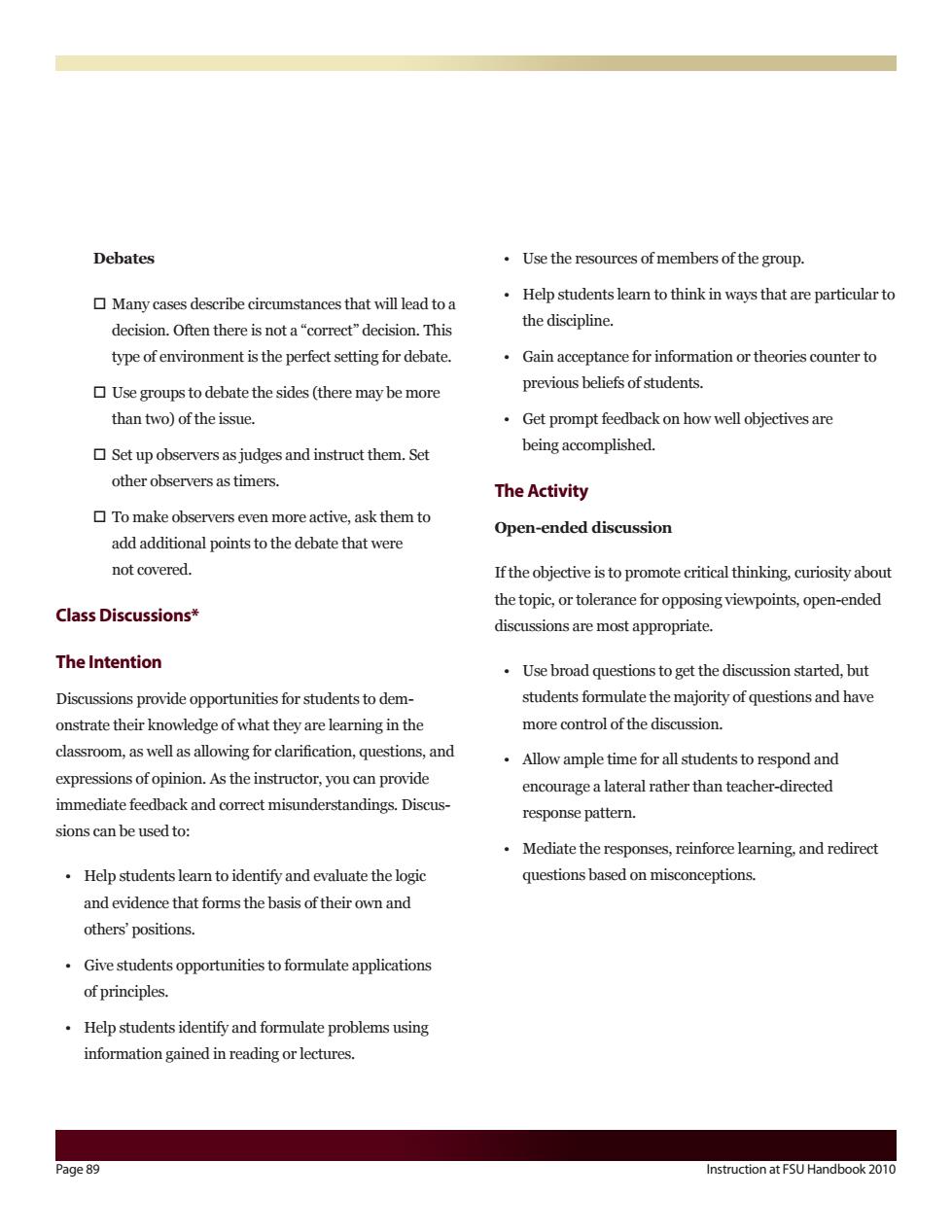正在加载图片...

Debates Use the resources of members of the group. D Many cases describe circumstances that will lead to a .Help students learn to think in ways that are particular to decision.Often there.This thediscipline. type of environment is the perfect setting for debate. Gain acceptance for information or theories counter to Use groups to debate the sides (there may be mor previous beliefs of students. than two)of the issue. Get prompt feedback on how well obiectives are Set upobservers as judges and instruct them.Set other observers as timers. The Activity To make observers even more active,ask them to Open-ended discussion add additional points to the debate that were not covered. If the objective is to promote critical thinking.curiosity about the topic,ortolerance for opposing viewpoints,open-ended Class Discussions* discussions are most appropriate. The Intention .Use broad questions to get the discussion started,but Discussions provideopportunities for students to dem- students formulate the majority of questions and have onstrate their knowledge of what they are learning in the more control of the discussion. classroom,as well as allowing for clarification,questions,and Allow ample time for all students to respond and expressions of opinion.As the instructor,you can provide encourage a lateral rather than teacher-directed immediate feedback and correct misunderstandings.Discus- response pattern sions can be used to: Mediate the responses,reinforce learning,and redirect .Help students learn to identify and evaluate the logic questions based on misconceptions and evidence that forms the basis of their own and others'positions. .Give students opportunities to formulate applications of principles Help students identify and formulate problems using information gained in readingorlectures. nstruction at FSU Handb Page 89 Instruction at FSU Handbook 2010 Debates Many cases describe circumstances that will lead to a decision. Often there is not a “correct” decision. This type of environment is the perfect setting for debate. Use groups to debate the sides (there may be more than two) of the issue. Set up observers as judges and instruct them. Set other observers as timers. To make observers even more active, ask them to add additional points to the debate that were not covered. Class Discussions* The Intention Discussions provide opportunities for students to demonstrate their knowledge of what they are learning in the classroom, as well as allowing for clarification, questions, and expressions of opinion. As the instructor, you can provide immediate feedback and correct misunderstandings. Discussions can be used to: • Help students learn to identify and evaluate the logic and evidence that forms the basis of their own and others’ positions. • Give students opportunities to formulate applications of principles. • Help students identify and formulate problems using information gained in reading or lectures. • Use the resources of members of the group. • Help students learn to think in ways that are particular to the discipline. • Gain acceptance for information or theories counter to previous beliefs of students. • Get prompt feedback on how well objectives are being accomplished. The Activity Open-ended discussion If the objective is to promote critical thinking, curiosity about the topic, or tolerance for opposing viewpoints, open-ended discussions are most appropriate. • Use broad questions to get the discussion started, but students formulate the majority of questions and have more control of the discussion. • Allow ample time for all students to respond and encourage a lateral rather than teacher-directed response pattern. • Mediate the responses, reinforce learning, and redirect questions based on misconceptions